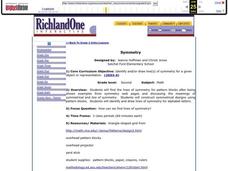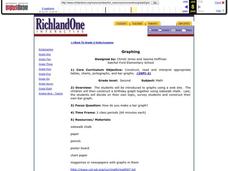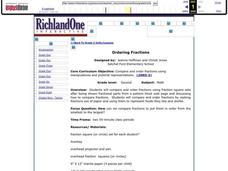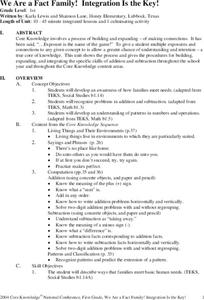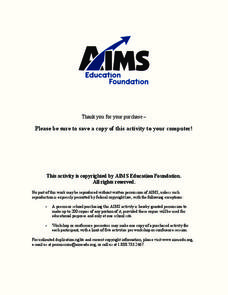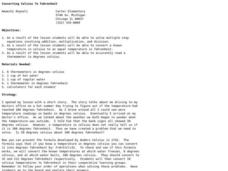Curated OER
Which Number Will Finish First?
Students conduct probability experiments. in this number lesson, students use spinners and conduct probability experiments. They collect and organize data on talley sheets.
Curated OER
Symmetry
Second graders find the lines of symmetry in pattern blocks and alphabet letters. In this symmetry lesson, 2nd graders discuss what symmetry is, view examples of lines of symmetry and apply what they have learned by finding the line of...
Curated OER
Fractions!
Second graders observe and design manipulatives showing fractional parts. In this fractional part activity, 2nd graders create a paper hamburger using circle fractions. Students navigate a website to find fractional parts of a hexagon.
Curated OER
Probability
Second graders experiment with probability. In this probability lesson plan, 2nd graders pick colored beans from a bag to find the chance of getting different colors. They make fair and unfair spinners and record the data after spinning...
Curated OER
Graphing
Learners investigate graphing. In this bar graph lesson, students view an informational website about graphing, then construct a class birthday bar graph outside with sidewalk chalk. Learners choose a survey topic, then collect data and...
Curated OER
Motion Geometry
Second graders experiment with slides, flips and turns to understand motion geometry. In this motion geometry lesson, 2nd graders navigate interactive motion geometry sites. Students illustrate the results of motion using paper models...
Curated OER
Ordering Fractions
Second graders use shapes to create various fractions. In this fractions lesson, 2nd graders define a fraction, visit a website where they make fractions using various shapes, and use a fraction square set to create and name fractions.
Curated OER
Patterns
Second graders work with different types of patterns. In this pattern lesson plan, 2nd graders go to a pattern block webpage and use Unifix cubes to create their own patterns. They find patterns in the real world and draw their own...
Curated OER
The Ins And Outs Of Area And Perimeter
Fifth graders demonstrate the concept of perimeter and area using manipulative. In this area and perimeter lesson, 5th graders explore area and perimeter through the exploration style of teaching using eatable and non-eatable...
Curated OER
We Are a Fact Family! Integration Is the Key!
Students practice addition and subtraction. In this fact families unit, students practice finding sums and differences for fact families. This unit includes ten lessons with science and social studies integration.
Curated OER
Making Change
Students investigate how to make change when purchasing items. In this making change lesson, students examine a scenario to calculate the correct change. Students play Bingo based on information and calculations to determine the amount...
Curated OER
Million Dollar Project
Students calculate how they will spend a million dollars. In this millionaire math lesson, students complete a worksheet and then make a poster of how they would spend a million dollars. Each item and its cost must be shown. a minimum...
Curated OER
Native American Pebble and Pot Game
Students participate in a game using 12 manipulatives. In this addition and subtraction lesson students play a game originated by the Native Americans and look at a number of items and calculate how many are hidden. Items looked at and...
Curated OER
Jelly Beans for Sale
Students connect literature (story Jelly Beans for Sale by Bruce McMillan) to math concepts. In these estimating and money lessons, students work with jelly beans, unifix cubes, pennies, nickels, dimes, and quarters, to estimate and make...
Curated OER
Survey and Tally
Second graders view a model of a survey and tally. In this survey and tally lesson plan, 2nd graders decide on questions for a survey. Students conduct the survey and tally their results. Students create a tally chart. Students view a...
Curated OER
Estimation
Third graders practice using money. For this estimation lesson, 3rd graders show their ability to figure out the cost of lunch. Students then set up a "store" and students choose the products and estmate the cost. Students visit websites...
Curated OER
The Game of Chance
Third graders use manipulatives to determine the probability of outcomes. In this probability lesson, 3rd graders roll dice and use spinners to determine the probability of outcomes. They determine if games are fair/unfair based on their...
Curated OER
Bar Graphs
Third graders investigate bar graphs. In this third grade mathematics lesson, 3rd graders collect and analyze data and use the internet’s Graph challenge to create their own graphs. Students write questions for the other students to...
Curated OER
Debit or Credit-You Decide
Students identify the similarities and differences between an debit and credit card. In this debit or credit lesson plan, student explain the advantages and disadvantages of using cash and consumer credit to purchase good and services...
Curated OER
Project Whistlestop:Missouri Vacation Learning Unit
Fourth graders reserach the state of Missouri. In this Missouri History lesson, 4th graders plan a vacation to a region of Missouri. Students work in collaborative groups to determine all aspects of the trip. Students use math skills for...
Curated OER
Bears Wear Buttons
Students practice counting sets of objects and numerals. In this numerical identification lesson, students listen to the story, Bears Wears Buttons, and participate in a flash card activity where students must place buttons on a card...
Curated OER
Greenhouse Effect: Pop Bottle Experiment
Students explore global warming by conducting a weather experiment. In this greenhouse gas lesson, students define the greenhouse effect and the impact on our ozone layer. Students utilize a soda pop bottle, floodlight bulb, thermometers...
Curated OER
Converting Celsius to Fahrenheit
Learners convert from Celsius to Fahrenheit. In this converting lesson, students explore temperature conversions. They use a thermometer to determine the temperature of given items.
Curated OER
How many isosceles triangles can you find?
Seventh graders recognize the characteristics of isosceles triangles. In this isosceles triangle lesson, 7th graders use geoboards to create isosceles triangles. Students record results and explain why they have an isosceles triangle.



